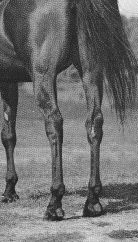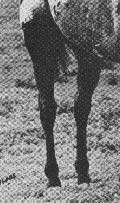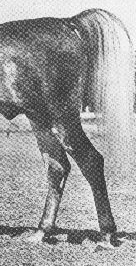Arabians, NSH & Pintos with
excellent dispositions.
Are you in someone else's frames?
Ride on out of thereIf you wish to listen to music while visiting my pages, please feel free to and I hope you enjoy.
Conformation Clinic: Hindlegs
Yet MORE legs! These are mostly hind legs, in various shapes, angles and sizes. Since hind legs are conformed somewhat differently than fore, they have their own set of flaws. Some are the same on the other end (like standing close, and toeing in or out) and some are unique to hind limbs (like sickle hocks)
As before, the following are some (but not all) common flaws illustrated by anonymous horses. Not all faults are equal in severity. Also, as the degree of the flaw varies, so do the problems the flaw can cause, from slight to severe.
A horse used to illustrate a good or less good point may have other points that are good or not so good. The angle of the hind pasterns is generally a bit steeper than the desired 45 degree fore. The hindlimbs are "tested" in photos by laying a straight edge along the hind leg from fetlock to hock. The line should continue upward to just touch the outermost point of the rear end. The direction and amount of miss determines the fault and the severity. Too straight hocks will have an edge falling from the point of the butt disect the hind limb rather than falling behind, along, or in front.
 |
At left, a horse with straight hind legs from a 3/4 rear view. | Cowhocked at right, with the off hind being the culprit. Accompanied by a toe-out. |
 |
 straight hind legs |
 camped out behind |
 too straight or "posty" |
 sickle hocked |
 |
The horse at left is base-narrow. His legs get evenly closer, on a slanted line, as they go down to his hooves. | The right photo shows hind legs close from the hocks down. The line down is straight, but too close from the hocks to the hooves. Also accompanied by a toe-out. |
 |
 |
At left is a horse showing good bone, and also the best "well let down" low hocks. |
While at right is a horse showing light bone, although both horses exhibit desired, flat bone. |
 |
 |
The horse on the left illustrates a higher set than desirable hock. | The horse on the right shows a better "let down" hock. |
 |
| Younger horses will often have higher hocks until they become more mature. The higher the hock, in relation, the longer the rear cannon bone. |
AND THEIR FAULTS | |
 good pasterns |
 upright pasterns |
 short pasterns |
 soft pasterns |
 |
This shows a slight club foot, with the hoof angle too upright, it gives the horse a slight "tip-toe" appearance. A club foot will often not interefere at all with a horse's performance and it is not definitely known to be heritable or not. |  |
Next Conformation Page?
About Us Our Mares Our Foals
Sales List A Special Tribute Equine Tips
Homemade Horse Treats Greeting Cards Rank Our Site
Conformation Clinics Reference Sires & Dams
Sign My Guestbook View My Guestbook
Web Rings Banner Exchange Awards
Website Portfolio
Last updated December 10, 2000 by Buffy MacLeod
Check out the Top Rated Site for Webmaster Tools!


